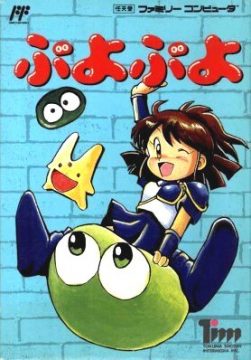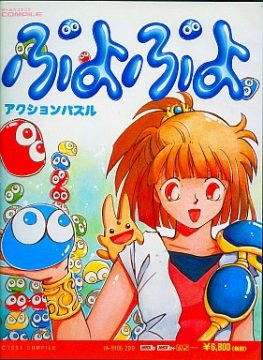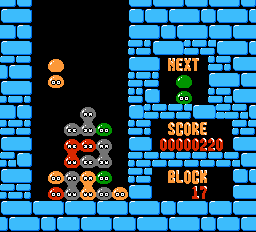Puyo Puyo started as an MSX2 and Famicom Disk System game released in 1991. As is to be expected, it’s pretty bare. However, that doesn’t make it any less engaging. The game comes in two modes: single-player and two-player mode. In single-player mode, you’re given two further options: Endless Mode and Mission Mode.
In Endless Mode, all you have to do is keep clearing Puyo indefinitely. Even though it sounds simple, the game makes sure to throw multiple obstacles at you to mix things up. For starters, depending on how many Puyo you clear, the game gets steadily faster, ramping up until a certain point at which it decides to cool down a bit before starting to pick up speed more and more. You initially start with four colors to deal with, but to further add to the difficulty, more and more get added on as you progress. Although the combination of high speed and many colors may seem outright brutal at first, there’s actually a strategy to deal with this. Sooner or later it becomes clear that the best thing to do is to just build up a large chain instead of clearing Puyo four at a time continuously. After all, the game doesn’t pick up speed while you’re setting up, and there’s no timer on your actions.
That’s not the only point in the player’s favor, either. At the beginning of every marathon game, you’re given a choice between two items to help you after a certain amount of time has passed: Carbuncle, or a Big Puyo. The Big Puyo, once dropped, clears every Puyo underneath its two-space-wide size. Carbuncle moves down the entire column of Puyo it’s placed upon, changing them all to that same color. What’s more, if there’s a Puyo on the bottom row with the same color as the ones that are being changed nearby, Carbuncle will move to it, possibly affecting even more Puyo in the way before finally stopping its rampage. There’s also the choice of using no item at all, if you want to make things harder on yourself.
In Mission Mode, you’re tasked with clearing a certain objective every level, starting with a preset arrangement of Puyo on the board. The objectives are surprisingly varied, such as clearing a certain color of Puyo from the board, clearing a certain amount of Puyo at once, or making a chain a certain size long. There are around 50 missions to clear, each one getting harder as you go along, and your progress is thankfully saved (four digit password in the later Famicom cartridge version), so getting through this mode takes a while.
The two-player mode is rather simplistic, and follows the basic rules outlined previously. Namely, you make chains in order to fill your opponent’s side of the screen. There are no items or anything to spice things up, however, so it can get boring after a while.
Even though the different versions of this game are identical in terms of mechanics, the Famicom release tends to be easier, since the marathon mode picks up at a slower pace than the MSX2 version. It also features an alternate skin for the Puyo, in the shape of people. On the other hand, the music in the MSX2 version sounds a bit better due to a wider range of instruments.
Puyo Puyo (ぷよぷよ) / Dr. Robotnik’s Mean Bean Machine / Kirby’s Avalanche / Kirby’s Ghost Trap – Arcade, Mega Drive, PC Engine CD, Game Gear, Super Famicom, PC-98, X68000, FM Towns, Game Boy, Macintosh, Windows, GameCube, PlayStation 2, Xbox, N-Gage, Mobile, PlayStation 3, Xbox 360, Wii, 3DS (1992)
Puyo Puyo really came into its own with the arcade version, which was developed in collaboration with Sega. This marked the beginning of a relationship between the two companies, which plays an important role later on. As far as the first game is concerned, the only things that this affected was that Sega systems took priority on home ports of the games, and because they were handled by Sega, those versions were usually made with Sega’s systems in mind (because they run on hardware similar to the Mega Drive).
Arle, one of the characters in the MSX2 original, had already been on the cover and title screen of the that game, but now she actually plays a role as the heroine. Accordingly, this version has a bit of a story: Arle learns a spell and wants to use it to defeat a man named Satan. It’s not exactly a gripping plot, but it’s just there to move the game along.
Characters
Arle Nadja
The heroine of this story. She says her spells in english, but due to the Japanese accent of the voice actress, they always come out weird (FIYAH instead of fire, ICE SYSTAMU instead of ice storm, etc.).
Skeleton-T
A skeleton who likes to drink tea, even though he lacks a tongue, or any skin or organs for that matter.
Nasu Grave
A talking eggplant that wears glasses. His character traits are that he tends to say “Nasu” at the end of every sentence, and he’s afraid of being squashed.
Mummy
A mummy that talks and doesn’t really seem that harmful. Its main strategy is to try and wrap opponents up, but since it has to get close and never changes things up, this never works.
Draco Centauros
A surprisingly feisty dragon. She’s insecure about her own beauty in relation to others, so she randomly challenges other women to beauty contests.
Suketoudara
A fish with arms and legs. Why? Because he likes dancing. He’s actually pretty energetic, especially in the later games – his favorite phrase is, “IT’S DANCING”.
Sukiyapodes
A foot monster – yes, that’s actually a thing. He’s incorrectly called Sukiyapotes in this game due to a translation error.
Harpy
A human harpy whose singing is, in this game, so good that she barely listens to anyone else, but in the later games it is so bad that everyone wants her to stop.
Sasoriman
A scorpion man (that’s actually what his name means) who’s shy, but never seems to stop smiling. He’s actually rather polite in every encounter with him – not polite enough to step out of the way, but still.
Panotty
He plays the flute, and gets pretty angry if people don’t like his music – since he plays his flute in every game he appears in and nobody understands his “genius”, he gets angry quite a bit.
Zombie
A zombie that loves metal music, for some reason – so much so that he plays a guitar in another game, and is surprisingly good at it.
Witch
A witch. She wants to be a powerful magic user, so since Arle is rather powerful herself, Witch obviously gets in her way multiple times.
Zoh Diamoh
An Indian elephant. Since he’s a big guy, he has a tendency to shake the earth whenever he stomps down. When you play puyo against him, every set of puyo he drops even makes a thud, which is a unique quirk that is carried over into every game.
Schezo Wegey
A dark wizard. He seems cool until you actually hear him speak. He says phrases that are easy to misinterpret into a perverted meaning (“Be my desire”, for example); this causes him to be called a pervert often, much to his anger. His voice actor shifts a lot from game to game.
Minotauros
The axe-wielding Minotaur(os) is the bodyguard of a woman named Rulue, who he actually has a crush on.
Rulue
She calls herself the fighting queen, and has a love for a man named Satan, much to the dismay of Minotauros. Because of her love for Satan, she’ll do anything for him, which usually means trying to stop Arle.
Satan
The final boss of this game (and many others), and the ruler of Puyo Hell. Surprisingly, in the earlier games he’s quite obsessed with Carbuncle, but he later falls in love with Arle and keeps claiming that she’s his fiancé. The creator of the series likes to cosplay as him.
Carbuncle
A cute, yellow… thing that constantly travels with Arle. You’ll see him do a lot of small dances here and there during your puyo matches, and he likes to start off every battle by popping a bubble he inflates. His only line is “Guu” in any and every game. Of course, only Arle ever understands him.
The characters in this game have a lot of quirks about them, and their silly animations are really fun to watch. Much of the cast make return appearances in later games, too; it’s nice to see just how many ways Compile can exploit their traits to make fun dialog.
The arcade mode features three difficulties. The easy mode pits you against three foes and goes at a slow pace perfect for beginners. In the first stage, the game highlights relevant Puyo when you have an opportunity to make a chain, though it takes the training wheels off afterwards. Normal mode is where the actual story takes place, pitting you up against a total of 13 foes. “Difficult” just starts at stage 4 of Normal mode.
The main trick of this game is that the speed of falling Puyo increases significantly even within a single stage, making the game become extremely difficult very quickly, especially to newcomers of the series. Thankfully, there’s a way to ease the challenge – every time you get a game over and continue (at the cost of a credit, of course), the drop speed decreases by a few stages. So, all inexperienced players have to do is feed more and more money to the machine to make it easier, which is completely fair if you don’t think about it too much.
The home ports of the game are all pretty much spot-on to the arcade version, but there are some neat little additions. There’s a marathon mode (sometimes called “endless” or “exercise”, just like the original Puyo Puyo, and of course, a separate two-player mode. You can also change the difficulty between easy, normal, hard, and hardest, not only making it easier for newer players to get into, but extending the replay value a little bit. There’s also a button test mode, so that when the losing player of a match blames their controller, you can call them out on it. The versions for PC-98 and Windows PCs have gorgeous high resolution graphics, for everything except the Puyos, oddly. Out of all of the ports, however, the PC Engine version has the best presentation: the instruments for the music are pretty good (though the in-game music is still played via the system’s sound chip rather than redbook audio), and every line in the story mode is fully voiced, a trend that started to carry over to other “high-end” ports of future games. The only other real difference is the slightly brighter color palette, which, in the case of the opening areas, makes the background less distinct from the frame.
Puyo Puyo isn’t exactly a technologically demanding game, so it only ran into difficulties on the Game Boy. Since the series relies heavily upon colors for distinction between its pieces, and there are up to five different pieces in total, putting it on a handheld that can only display shades of green seems like an unnatural choice. To help tell Puyo apart, some are a shaded lighter or darker than others, and they all have different shapes. However, many of these shapes are quite similar to one another, and since the screen of the handheld is so small, telling Puyo apart can be quite a trial. It’s easy to confuse one Puyo for another and completely ruin a chain you’ve worked on. The game moves at a slower pace than the previous versions, so battles easily feel as if they’ll drag on for too long. The music and sound effects are likewise disappointing, with some being quite grating: the sound effect used for moving Puyo, for example, is a sharp, loud noise, and since it happens so often in a normal match, it’s best to mute the game.
The Game Boy ports aren’t exactly noteworthy at the start, however it’s important to make note of them as they eventually become their own separate experiences, adding various innovations in an attempt to learn from the mistakes made in early releases. This particular port doesn’t add anything to the base game and is very difficult to play competently as well, so it can easily be skipped.
In 2001, Sega published mobile phone versions in both of its app series, Sega Ages and Sonic Cafe. The default apps could only be played alone, while the two-player mode was sold separately as Futari de Puyo Puyo. The “Yoko” version on Sonic Cafe could even be played by two players on one phone, as the playing fields were placed sideways to face opposite directions. Since neither version seems to have included the story mode, they could almost be regarded as ports of the MSX2 game, if it wasn’t for Arle’s face showing up on the side of the screen. In 2003, Sega finally followed up with a new mobile version that faithfully recreates the arcade game, aside from the mandatory squished display.
Despite the massive success of Tetris (and general liking of variations like Columns), it took quite a long time for Puyo Puyo to truly leave Japan. There was an English language version for the arcades, but it received sparse distribution. This version features English language voice samples and changes the names of some of the characters. Some are attempts to translate the names into English – Sukiyapotes is Small Foot, for example. As for other examples, Arle is now Silvana, Schezo is now Devious, Satan is the Dark Prince, and Rulue is Lulu.
For the console ports, Sega and Nintendo decided to put their own mascots into Puyo Puyo, in hopes of drawing a wider audience. The results were Dr. Robotnik’s Mean Bean Machine (for the Genesis, Game Gear, and Master System) and Kirby’s Avalanche (for the SNES, AKA Kirby’s Ghost Trap in Europe and Japan).
Mean Bean Machine has an absurd plot where the evil scientist Robotnik was trying to take over Bean Town, or something equally ridiculous. The Puyos here are referred to as “beans” for some reason, with Nuisance Puyos renamed “Refugee Beans”. Your opponents are taken from the Sonic the Hedgehog cartoon (the syndicated one, not the one on ABC), including Grounder, Coconuts, Scratch, and finally. Robotnik himself. Carbuncle is still running around, though he’s been renamed “Has Bean”, a former bean who has been turned into a robot. A lot of the music comes from the original Puyo Puyo, just used in different places and with a changed instrument set. It also features a password system, which is quite welcome. The Game Gear version includes some levels from Nazo Puyo, and the Genesis version can be found on many compilations.
The Super Famicom version, named Super Puyo Puyo, was published in Japan by Banpresto. It’s mostly a straight port, though due to the lower resolution of the system, the middle divider has been made smaller, and the opponent picture now appears in their playing field, rather than the center of the screen. As for the overseas versions, Nintendo and HAL went into more effort in reworking the way the game looks and sounds, at least compared to Dr. Robotnik’s Mean Bean Machine, which was basically the same game just with different cutscene visuals and opponents. Here, all of the backgrounds and music are all new, plus Kirby has been recast in Carbuncle’s role.
Interestingly, if you put the Japanese Game Gear version of Puyo Puyo into a non-Japanese system, it’ll change into an English version of the game called Puzlow Kids. The translation for this is the same as the English language arcade ROMs.
There were two Western variants of Puyo Puyo brought out by different companies. In 1995, Spectrum Holobyte released a version for Windows 3.1 called Qwirks. The visuals are SVGA, but while the beans look the same, the opponents are CG-rendered birds, bugs, and other things. The new MIDI soundtrack is quite poor, and the purple background color scheme is ugly. Strangely, the game is introduced by Tetris creator Alexey Pajitnov, despite him having no involvement here.
Disney Interactive brought out their own version of Puyo Puyo for Win 95 and Mac. Dubbed Timon & Pumbaa’s Bug Drop, the game features the Lion King characters, who narrate the action. As the title suggests, the Puyos are replaced with bugs. Despite the nice graphics, it’s a minimalist game, with only single and two-player modes, no variation in the boards, and lame music. The game is credited to a company called 7th Level, but the back of the box says “Bug Drop Game system from Puyo Puyo copyright Compile”.
Screenshot Comparisons
Localization Comparisons




